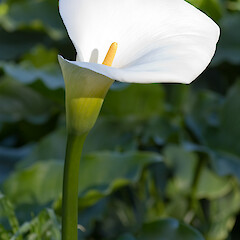Zantedeschia aethiopica
Common name
arum lily
Family
Araceae
Flora category
Vascular – Exotic
Structural class
Herbs - Monocots
NVS code
The National Vegetation Survey (NVS) Databank is a physical archive and electronic databank containing records of over 94,000 vegetation survey plots - including data from over 19,000 permanent plots. NVS maintains a standard set of species code abbreviations that correspond to standard scientific plant names from the Ngä Tipu o Aotearoa - New Zealand Plants database.
ZANAET
Conservation status
Not applicable
Brief description
Evergreen clump forming plant with large arrowhead shaped leaves ( up to 45 cm long and 25 cm wide) and pure white funnel shaped flowers (up to 25 cm long) with a bright yellow narrow sausage shaped centre (actually the flowers, the white part is a modified leaf).
Distribution
Scattered throughout northern North Island, less common in southern North Island and northern South Island.
Habitat
Swampy areas, often under willows and damp pasture and waste land.
Wetland plant indicator status rating
Information derived from the revised national wetland plant list prepared to assist councils in delineating and monitoring wetlands (Clarkson et al., 2021 Manaaki Whenua – Landcare Research Contract Report LC3975 for Hawke’s Bay Regional Council). The national plant list categorises plants by the extent to which they are found in wetlands and not ‘drylands’. The indicator status ratings are OBL (obligate wetland), FACW (facultative wetland), FAC (facultative), FACU (facultative upland), and UPL (obligate upland). If you have suggestions for the Wetland Indicator Status Rating, please contact: [Enable JavaScript to view protected content]
FAC: Facultative
Commonly occurs as either a hydrophyte or non-hydrophyte (non-wetlands).
Detailed description
Robust, evergreen, erect, clump-forming, to 1.5 m high, in close-set tufts from a tuberous rootstock with white fleshy roots; new tubers arising from shoots on the rootstock. Leaves large, leathery; laminae sagittate or ovate-cordate, 15-45 × 10-25 cm, dark green, the very fine veins somewhat lighter green, shining, entire, tip apiculate, margins undulate; petiole 40-100 cm long, lighter green, spongy, white on inside, purplish on outside. Scape ± = leaves, green, stout. Spathe ivory-white, bright green at base on outside, to 25 cm long, funnel-shaped, narrowed towards tip with a recurved apiculus to 2 cm long. Spadix ± ½ spathe, bright yellow; basal female zone, with staminodia interspersed, c. ¼-½ length of spadix, contiguous with upper male zone; sterile terminal appendage 0. Berries green or yellow, to ± 1 cm diam.
Similar taxa
Unlike most other wetland plants, but two other large plants in the arum family are superficially similar. Taro (Colocasia esculenta) and elephant ear (Alocasia brisbanensis) also have large leaves but arum can be distinguished by the veins of the leaf being the same colour as the rest of the leaf and the spathe being white
Flowering
October to December
Flower colours
White, Yellow
Fruiting
Summer to autumn
Life cycle
Perennial. Seeds dispersed by water movement, birds and other animals. Local clonal spread by rhizomes, with longer distance spread by water movement, deliberate planting and garden discards.
Year naturalised
1870
Origin
South Africa
Reason for introduction
Ornamental plant
Control techniques
Can be controlled manually, mechanically or herbicidally depending on situation.
Tolerances
Tolerates wet (drought-resistant once established), wind, salt, hot to cold, most soil types, mod shade.
National Pest Plant Accord species
This plant is listed in the 2020 National Pest Plant Accord. The National Pest Plant Accord (NPPA) is an agreement to prevent the sale and/or distribution of specified pest plants where either formal or casual horticultural trade is the most significant way of spreading the plant in New Zealand. For up to date information and an electronic copy of the 2020 Pest Plant Accord manual (including plant information and images) visit the MPI website.
Poisonous plant
When ingested this species causes burning of the mouth and alimentary canal. It also causes stomach pains and vomiting.
Attribution
Prepared by Paul Champion and Deborah Hofstra (NIWA). Features description taken from Croasdale et al. (1994).
References and further reading
Croasdale, H., Flint E. A. and Racine, M. M. (1994). Flora of New Zealand Volume 3: Freshwater algae, chlorophyta, desmids with ecological comments on their habitats, Staurodesmus Staurastrum and the Filamentous desmids. Manaaki Whenua Press: Lincoln, New Zealand.
Weeds of Australia (http://keyserver.lucidcentral.org/weeds/data/03030800-0b07-490a-8d04-0605030c0f01/media/Html/Zantedeschia_aethiopica.htm)
Johnson PN, Brooke PA (1989). Wetland plants in New Zealand. DSIR Field Guide, DSIR Publishing, Wellington. 319pp.
Popay et al (2010). An illustrated guide to common weeds of New Zealand, third edition. NZ Plant Protection Society Inc, 416pp.





